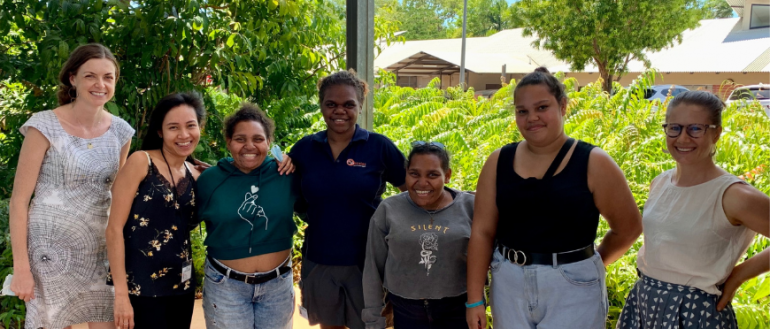Image caption: The team celebrated after the successful first day of the youth diabetes co-design workshop at Menzies.
The Northern Territory has the highest prevalence of youth type 2 diabetes (T2D) in the world.
The heaviest burden is felt by Central Australian Aboriginal females aged 15 to 24 years, where 1 in 33 young people have the condition. That’s 10 times higher than Australia’s general youth population.
Given the emerging T2D epidemic in Australia and internationally, effective management strategies are needed to improve diabetes outcomes for young people.
Professor Louise Maple-Brown and Dr Renae Kirkham from Menzies’ Diabetes Across the Lifecourse: Northern Australia Partnership, are leading research to explore the experiences of T2D among Aboriginal and Torres Strait Islander youth across northern Australia.
In this new study, 27 Aboriginal and Torres Strait Islander youth in the Northern Territory aged 10 to 25 years participated in in-depth interviews. Interviews explored their experience of living with diabetes, their available supports, along with understandings and strategies for managing the condition.
Aboriginal researchers were involved at all stages of data collection, data analysis, interpretation and dissemination of findings and implementation of strategies.
The study highlights suboptimal levels of understanding about the condition. One participant said, “I don’t really know what diabetes is. I just need somebody to explain it to me a bit more.”
Anna* was 12-years-old when diagnosed while on a football trip.
“They took me to the hospital and then they said that I had a rheumatic heart and then they did another test of my blood sugar and it was around 23.5 and then they did some other tests and they said that I had diabetes.”
Many participants talked about diabetes being normalised among their communities.
“Mum, well, she passed away. She had diabetes too. And my grandfather, he had diabetes but was on dialysis. And my dad too… and my mum’s dad, my grandfather, he had diabetes, and then my big sister, she’s 17, she has diabetes too,” Anna said.
For many young people being diagnosed with T2D caused shock, and led to confusion, worry, anger and stress.
Louise* is 17-years-old and found her diagnosis was very emotional.
“I was full-on crying. I just wanted to get out of there… I didn’t want to believe it. It was horrible. Horrible… horrible when I found out.”
The paper’s senior author, Dr Renae Kirkham, said the successful management of T2D requires appropriate support from health professionals and family, and includes strengthening social networks and educational opportunities.
“Our findings reinforce the need for support systems tailored to the specific needs of young Aboriginal and Torres Strait Islander people with type 2 diabetes,” she said.
“They also highlight that young people do not exist in isolation and that managing their diabetes is often not their only priority.”
“Enhanced models of care must be codesigned with young people and their communities and include a focus on shifting norms and expectations about youth type 2 diabetes to reduce the diabetes stigma and broaden social support; it is also important to consider the delivery of health information in youth-friendly environments,” Dr Kirkham said.
The study presented findings that have relevance to other First Nations populations worldwide.
The paper titled: “I Don’t Really Know What Diabetes Is”: A Qualitative Study Exploring the Experiences of Aboriginal and Torres Strait Islander Young People Aged 10 to 25 Years Living With Type 2 Diabetes in Northern and Central Australia - is published online in the Canadian Journal of Diabetes.
The full study is available here: https://doi.org/10.1016/j.jcjd.2022.04.010
*Names of the participants have been changed to protect their identity.

